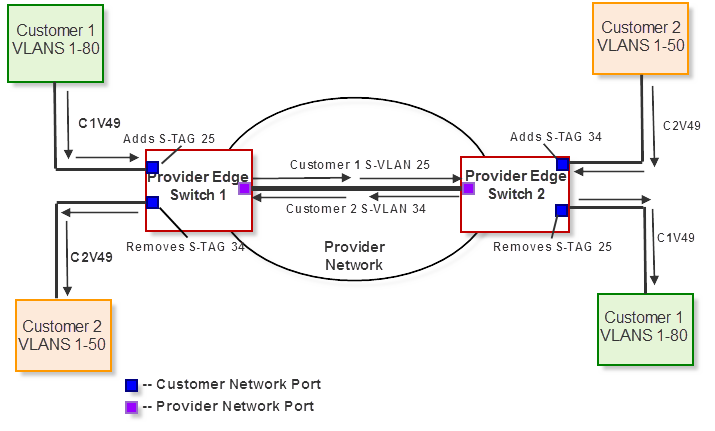By extending VLAN tagging technology via the IEEE 802.1Q-2011 standard, an organization managing a service provider network can provide external user groups (departments, customers) to each have their own separate logical network (a LAN consisting of multiple VLANs) through the provider network to predefined egress ports. The provider can assign a single VLAN through their network for all traffic egressing through a port, instead of having to create and manage a separate VLAN for each customer VLAN. This feature, commonly called Provider Bridges (also VLAN stacking, or Q-in-Q), performs Layer 2 tunneling from one customer network location through the provider network to another customer network location.
Provider bridges allow a service provider to assign customer traffic to a service instance called an S-VLAN (Service VLAN). When a packet from a customer VLAN arrives on an S- K- and 7100-Series switch at the edge of the provider network, it is already identified by a tag called a C-TAG (customer tag). The edge switch encapsulates the packet with another tag called an S-TAG (service provider tag) for relay through the service provider network. The packet egresses from the provider network to the destination customer site through an egress port at which the S-TAG is stripped off. The packet continues on to the remote customer network guided by its original C-VLAN tagging, unaltered.
Provider Bridge VLAN Tags
| TAG Name | Description |
|---|---|
| C-TAG | Customer VLAN tag. 32 bit tag where the first 16 bits represent the ether type for the customer (0x8100) and the lower 16 bits represent the Priority Code Point (PCP), Canonical Frame Indicator (CFI), and customer VLAN ID (C-VID) associated with the packet. |
| S-TAG | Service provider VLAN tag. 32 bit tag where the first 16 bits represent the ether type for the service provider (0x88a8) and the lower 16 bits represent the PCP, DE (Drop Eligible), and service provider VLAN ID (S-VID) associated with the packet. |
Provider Bridges in Provider Network illustrates the Provider Bridges function in a provider network with two customers, each with a campus on either side of the provider network and the need to connect their VLANs inexpensively, transparently, and securely. VLAN 49 from Customer 1 ingresses the provider network through the Customer Network Port (CNP) on Provider Edge Switch 1, which adds S-TAG 25 to packets with the C-VID for Customer 1 VLAN 49 (C1V49). After traversing the provider network as S-VLAN 25, the packets egress the provider network at the designated CNP on Provider Edge Switch 2, where the S-TAG 25 is removed and the packets are forwarded to their destination. Even though Customer 2 has a VLAN 49 (C2V49), this traffic is tagged with S-TAG 34 and traverses the provider network as S-VLAN 34.

If other traffic from Customer 1 (for example, VLAN 22) must traverse the provider network to get to the remote Customer 1 campus, the provider edge switches would add the S-TAG for S-VLAN 25 on C1V22 packets as well. In this way all Customer 1 traffic (80 VLANs) can pass over the provider network using a single S-VLAN, and arrive at their destinations with C-VLAN intact.
Provider Bridge-related Port Types defines the types of ports used in the Provider Bridge architecture. In hardware terms they are identical, but they differ in their roles in the bridging feature architecture.
Provider Bridge-related Port Types
| Port Type | Description |
|---|---|
| Customer Bridge Port | Customer bridge ports are the existing, default type of ports carrying C-VLAN traffic on provider edge switches. They interpret the C-TAG and relay packets using the C-VID. |
| Customer Network Port (CNPs) | CNPs are ports resident on provider edge switches that connect the customer network to the provider network. Traffic received on a CNP is assigned to an S-VID based on the ingress settings of the CNP and encapsulated with an S-TAG. CNPs remove the S-TAG from the packets egressing the provider network. In cases where two provider networks are connected via CNPs, packets egress the device with the S-TAG. In these cases the ingress S-VID is translated to a relay S-VID which maps the S-VLANs of one provider network to the S-VLANs of the second provider network. Customer Network Ports are configured as untagged egress ports via the set vlan egress command. |
| Provider Network Port (PNPs) | PNPs interconnect switches within the provider network and operate using S-TAGs and S-VIDs for relay operation. Provider Network Ports are configured as tagged egress ports via the set vlan egress command. |

 Print
this page
Print
this page Email this topic
Email this topic Feedback
Feedback